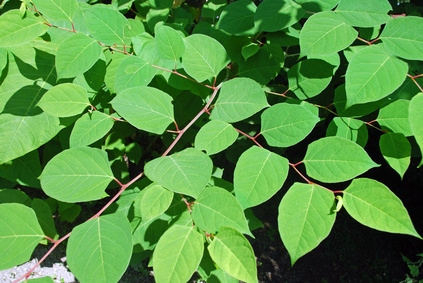Japanese Knotweed – dealing with the invasive plant
Date published: 25 January 2015

Japanese Knotweed (Fallopia japonica)
Japanese Knotweed (Fallopia japonica) is an invasive plant that costs UK property owners millions of pounds each year – a result of its ability to grow in even the most awkward places, including through small gaps in concrete and brickwork.
The species is notorious for its rapid growth – a small root can become a large, dense patch of the plant in a short space of time – and it has been illegal to plant Knotweed in the wild since the 1980s.
But further regulations were also introduced towards the end of 2014 that meant an antisocial behaviour order (ASBO) could be issued to anyone who allows Knotweed to spread when they could have been reasonably expected to prevent it from doing so.
The site of Number One Riverside, the council’s offices, had to be cleared of the plant before building could commence, and patches of the plant were reported in the river close to the police station, on The Esplanade.
Mark Widdup, Director of Economy and Environment at Rochdale Council, said: “The Japanese Knotweed on the site of Number One Riverside was treated prior to construction and there have been no further cases here or near to the police station. While the responsibility for clearing this weed lies with the land-owner, we can offer advice to anyone struggling to control it by calling 0300 303 8871.”
There are several things to be aware off when identifying Knotweed and having it removed. The Government website has useful information, but these are the main things to look out for:
- The plant’s leaves are broad and round, with a pointed tip, and it also sprouts clusters of small flowers.
- Its roots are thick and similar in appearance to rhubarb. They are usually very close together, and the stems can grow up to 20cm per day.
- The plant does not spread via seeds and instead moves when parts of the root are broken off and transported, for example by a river or stream. This is why it is important that Knotweed is removed and disposed of properly.
Japanese Knotweed is best removed by spraying it with herbicide, but a person carrying out this work must hold relevant certification. The plant can also be dug out, but it is important that this is done properly and the waste is disposed of correctly. Failure to do so could result in a hefty fine.
Anyone concerned about Japanese Knotweed in Rochdale should contact the council’s Environmental Health department on 0300 303 8871.
Do you have a story for us?
Let us know by emailing news@rochdaleonline.co.uk
All contact will be treated in confidence.
Most Viewed News Stories
- 1Former councillor and hospital campaigner Jean Ashworth has died
- 2Northern Healthcare opens supported living service in former Rochdale hotel
- 3Middleton school hails another outstanding inspection result
- 4Family event to celebrate Earth Day to be held at Number One Riverside
- 5Rochdale man charged after teenager attacked with substance in Stockport
To contact the Rochdale Online news desk, email news@rochdaleonline.co.uk or visit our news submission page.
To get the latest news on your desktop or mobile, follow Rochdale Online on Twitter and Facebook.


